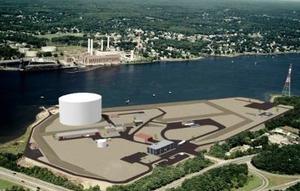InfrastructurePlan for Massachusetts LNG site faces growing opposition
The Weaver’s Cove energy project will see up to seventy liquefied natural gas (LNG) tankers a year travel up Narragansett Bay to berth in Mt. Hope Bay; from there, a sub-sea pipe would carry the liquefied gas more than four miles up the Taunton River to a storage facility at a former oil terminal; Massachusetts and Rhode Island politicians work to block the Fall River storage facility, saying a terrorist attack or accident would place thousands of people in peril in the densely populated city and harm fish habitat and tourism

The Weaver's Cove LNG site // Source: lngworldnews.com
A proposed liquefied natural gas project avoided a potentially crippling blow three weeks ago in Congress’ lame-duck session, but the controversial Weaver’s Cove proposal continues to face major political and other hurdles.
A bipartisan coalition of Massachusetts and Rhode Island politicians — including Republican Scott Brown and Democrat John F. Kerry — inserted language in the $1.2 trillion Senate omnibus budget bill prohibiting any of the money from being used to approve the project. The measure would have halted federal permitting for Weaver’s Cove, but Senate majority leader Harry Reid abandoned the full bill late Thursday night after support for it faltered.
The Boston Globe reports that members of the two states’ congressional delegations pledged to have the same provision added when the budget is ultimately debated, the latest turn in opponents’ ramped-up campaign to kill the nearly decade-old plan to deliver super-cooled natural gas to Fall River. Critics say a terrorist attack or accident would place thousands of people in peril in the densely populated city and harm fish habitat and tourism.
The city of Fall River, which opposes the project, is challenging Weaver’s Cove on calculations they used to determine the spread of flammable gas in an LNG pipe rupture, saying the company dramatically underestimated how large an area might be affected.
“We want to put a stake through this vampire’s heart,’’ said Representative Barney Frank, Democrat of Newton, who first inserted the spending prohibition into a House bill this year with Representative James P. McGovern, Democrat of Worcester, which Senate colleagues then picked up.
Only one other LNG storage facility exists on Massachusetts shores — in crowded Everett, where post-9/11 safety concerns have made it a national symbol of where not to place such facilities.
Yet Hess, the company behind the estimated $700 million Fall River project, will press ahead despite the continued and “disappointing’’ efforts to kill it, said Gordon Shearer, chairman of Weaver’s Cove Energy. He said the project will bring 1,000 jobs to the region and the political obstacles it has endured are unfair.
“It is most viable and needed,’’ said Shearer. “We have a process in place that allows people to evaluate and weigh these things. … So why can’t it be allowed to work here? Once you start bypassing [established procedures] where do you stop?’’
Hess now proposes to have up to seventy LNG tankers a year travel up Narragansett Bay to berth in Mt. Hope Bay. From there, a sub-sea pipe would carry the liquefied gas more than four miles up the Taunton River to a storage facility at a former oil terminal. Then it would be vaporized to go to homes or businesses or be shipped by truck as a liquid.
The Globe notes the company’s original proposal called for LNG tankers to dock at the Fall River terminal. While that plan was approved by the Federal Energy Regulatory Commission (FERC) in 2005, McGovern successfully blocked federal funding to demolish an old bridge, preventing the massive tankers from getting up the Taunton.
Weaver’s Cove then proposed using smaller vessels, but the U.S. Coast Guard rejected that, saying they would not be able to safely navigate the river or bridges. Now the energy commission is reviewing the plan to berth in Mt. Hope Bay, a spokeswoman said last week.
